JavaScript 中 this 指向所有场景详细分析
前端开发中,每天和我们见面最多的也许就是 this 关键字了,一直想总结一篇 this 的文章,然后看到了 Gentle Explanation of "this" in JavaScript ,总结的太好了,这里就翻译一下吧。
https://dmitripavlutin.com/gentle-explanation-of-this-in-javascript/
神秘的this
this 关键词已经折磨我很久很久了。
对于 Java、PHP 这类标准语言,this 表示当前类的实例化对象,它不能够在类的方法外使用,简单直接,因此并不会让人产生困惑。
但在 JavaScript 中情况就比较复杂了:this 指向当前函数调用的执行上下文(context),有四种函数调用类型:
- 函数直接调用(
function invocation:alert('Hello World!') - 方法调用(
method invocation:console.log('Hello World!') - 构造函数调用(
constructor invocation:new RegExp('\d') - 间接调用(
indirect invocation:alert.call(undefined, 'Hello World!')
每种调用方式都产生了各自不同的上下文,因此 this 有时候可能并不是我们所期待的。

此外,严格模式(strict mode)也会影响到 this 的指向。
弄清
this指向的关键就是对上边函数调用类型有一个清楚的判断
下边会详细介绍每一种调用类型的区别,以及它们是怎么影响 this 指向的,同时会举例说明一些容易判断出错的陷阱。
1 . 函数直接调用(function invocation)
定义:一个可以解析成函数对象的表达式,紧跟着左括号,然后是逗号分割的参数,最后是右括号。例如 parseInt('18')。
下边看一个简单的函数直接调用的例子:
function hello(name) {
return 'Hello ' + name + '!';
}
// Function invocation
const message = hello('World');hello('World') 就是一个函数直接调用:hello可以解析成一个函数对象,紧跟着是用括号括起来的 World 参数。
函数直接调用和通过对象属性 obj.myFunc() 是不同的,它叫做方法调用 method invocation(后边介绍的第 2 种类型)。比如 [1,5].join(',') 这种不是一个函数直接调用,而是方法调用。这两种是最容易混淆的,需要特别注意。
此外,一个 IIFE(immediately-invoked function expression) 也属于函数直接调用。
// IIFE
const message = (function(name) {
return 'Hello ' + name + '!';
})('World');第一对括号内的 (function(name) {...}) 是一个可以解析成函数对象的表达式,接下来的一对括号中 ('World') 括的就是参数列表。
1.1 函数直接调用中的 this 指向
首先需要知道全局对象是什么,不同执行环境中全局对象不同。在浏览器中全局对象是 window,Node.js 中的全局对象是 global。下边主要以浏览器的执行环境来分析。

在「函数直接调用」中,执行上下文就是全局对象,也就是 this 的指向。
让我们看下边的例子:
function sum(a, b) {
console.log(this === window); // => true
this.myNumber = 20; // add 'myNumber' property to global object
return a + b;
}
// sum() is invoked as a function
// this in sum() is a global object (window)
sum(15, 16); // => 31
window.myNumber; // => 20当调用 sum(15, 16) 的时候,JavaScript 会自动将 this 指向全局对象(浏览器中的 window)。
当 this 在函数外的顶级作用域中使用的时候,同样也是指向全局对象的:
console.log(this === window); // => true
this.myString = 'Hello World!';
console.log(window.myString); // => 'Hello World!'在 html 中的 script 中也是一样的。
<!-- In an html file -->
<script type="text/javascript">
console.log(this === window); // => true
</script>1.2 函数直接调用中的 this 指向(严格模式)
严格模式下,函数直接调用中的
this是undefined。
严格模式在ECMAScript 5.1 出现,对 js 一些语法进行了限制,可以提供一个更加安全、健壮的错误检查机制。
在函数体顶部加入 'user strict' 即可使用严格模式。
严格模式会影响当前上下文环境(context),在函数直接调用场景中,this 会变为 undefind,而不是上边介绍的全局对象。

下边举一个使用严格模式的例子:
function multiply(a, b) {
'use strict'; // enable the strict mode
console.log(this === undefined); // => true
return a * b;
}
// multiply() function invocation with strict mode enabled
// this in multiply() is undefined
multiply(2, 5); // => 10当使用严格模式调用 multiply(2, 5) 的时候,this 就是 undefined。
严格模式不仅对当前作用域有效,它内部的作用域(当前作用域内定义的函数内)也会是严格模式。
function execute() {
'use strict';
function concat(str1, str2) {
// the strict mode is enabled too
console.log(this === undefined); // => true
return str1 + str2;
}
console.log(this === undefined); // => true
// concat() is invoked as a function in strict mode
// this in concat() is undefined
concat('Hello', ' World!'); // => "Hello World!"
}
execute();上边的代码中,use strict 是写在 execute 函数体的头部,函数内部的 this 会是 undefined。同时,因为 concat 是定义在 execute 内部,它也会继承严格模式。因此 concat('Hello', ' World!') 的调用,其内部的 this 也会指向 undefined。
一个单独 js 文件可能包含多个作用域,因此不同的作用域可能分别处于非严格模式和严格模式。
function nonStrictSum(a, b) {
// non-strict mode
console.log(this === window); // => true
return a + b;
}
function strictSum(a, b) {
'use strict';
// strict mode is enabled
console.log(this === undefined); // => true
return a + b;
}
// nonStrictSum() is invoked as a function in non-strict mode
// this in nonStrictSum() is the window object
nonStrictSum(5, 6); // => 11
// strictSum() is invoked as a function in strict mode
// this in strictSum() is undefined
strictSum(8, 12); // => 201.3 陷阱:内部函数的 this 指向
⚠️一个很普遍的陷阱:对于函数直接调用,可能会认为如果是函数内部定义的函数,它的 this 会指向外部函数的上下文。
要始终记得,内部函数的 this 指向(除了箭头函数)只和它的调用类型相关(也就是本文介绍的几种类型),而不是它所在函数的上下文。
为了使 this 变成我们所期待的值,我们可以通过间接调用来实现(比如 .call() 或者 .apply(),下边第 4 节会介绍),或者创造一个绑定函数(使用 .bind(),下边第 5 节会介绍)。
看一下下边两数相加的例子:
const numbers = {
numberA: 5,
numberB: 10,
sum: function() {
console.log(this === numbers); // => true
function calculate() {
// this is window or undefined in strict mode
console.log(this === numbers); // => false
return this.numberA + this.numberB;
}
return calculate();
}
};
numbers.sum(); // => NaN or throws TypeError in strict mode⚠️ numbers.sum() 属于对象的一个方法调用,下一小节会讲。从代码分析,这里 calculate() 的结果其实就是 numbers.sum() 的结果 。因为 calculate 函数定义在 sum 中,sum 是 numbers 对象的属性,因此当调用 numbers.sum(), 我们会觉得 calculate 中的 this 也指向 numbers 对象。
重点来了,由于 calculate() 属于我们这一小节中讲的「函数直接调用」的类型,而不是下一小节的「方法调用」。所以 calculate 中的 this 指向全局对象 window,或者严格模式下的 undefined。即使在 numbers.sum() 中的 this 指向当前对象 numbers,但是它并不会影响 calculate 中的 this。
因此 numbers.sum() 的调用结果是 NaN (或者在严格模式下抛出一个错误 TypeError: Cannot read property 'numberA' of undefined)。而不是我们所期待的 5 + 10 = 15 。
为了解决这个问题,calculate() 函数必须拥有和 numbers.sum() 相同的 this 指向,这样在 calculate 中才能访问到 this.numberA 和 this.numberB。
一种解决方法就是使用 call 方法来手动改变 calculate() 中的 this 指向。(第 4 节的时候会介绍「间接调用」这种类型)
const numbers = {
numberA: 5,
numberB: 10,
sum: function() {
console.log(this === numbers); // => true
function calculate() {
console.log(this === numbers); // => true
return this.numberA + this.numberB;
}
// use .call() method to modify the context
return calculate.call(this);
}
};
numbers.sum(); // => 15calculate.call(this) 会正常执行 calculate()函数,同时会将它的执行上下文变为所传入的第一个参数。
现在 this.numberA + this.numberB 就相当于 number.numberA + numbers.numberB 了,所以结果就是 5 + 10 = 15 了。
另外一种解决方法看起来会更好,那就是通过箭头函数。
const numbers = {
numberA: 5,
numberB: 10,
sum: function() {
console.log(this === numbers); // => true
const calculate = () => {
console.log(this === numbers); // => true
return this.numberA + this.numberB;
}
return calculate();
}
};
numbers.sum(); // => 15箭头函数中的 this 会指向它所定义的地方,这里就是 numbers.sum 中的 this,会在第 6 讲中继续讲箭头函数。
2 方法调用
对象中的某个属性如果是函数,我们称其为方法。例如:
const myObject = {
// helloMethod is a method
helloMethod: function() {
return 'Hello World!';
}
};
const message = myObject.helloMethod();helloMethod 是 myObject 的一个方法。使用属性访问器 myObject.helloMethod 可以调用这个方法。
方法调用定义:通过属性访问器得到一个函数对象,紧跟着左括号,然后是逗号分割的参数,最后是右括号。例如上边的例子 myObject.helloMethod()。
更多其他的例子:[1, 2].join(',') or /\s/.test('beautiful world')。
再强调一遍,区分上一节介绍的「函数直接调用」类型和这一节介绍的「方法调用」非常重要。
const words = ['Hello', 'World'];
words.join(', '); // method invocation
const obj = {
myMethod() {
return new Date().toString();
}
};
obj.myMethod(); // method invocation
const func = obj.myMethod;
func(); // function invocation
parseFloat('16.6'); // function invocation
isNaN(0); // function invocation2.1 方法调用中的 this 指向
在方法调用中,
this指向拥有这个方法的对象。
当我们调用对象中的一个方法时,this 指向拥有这个方法的对象。
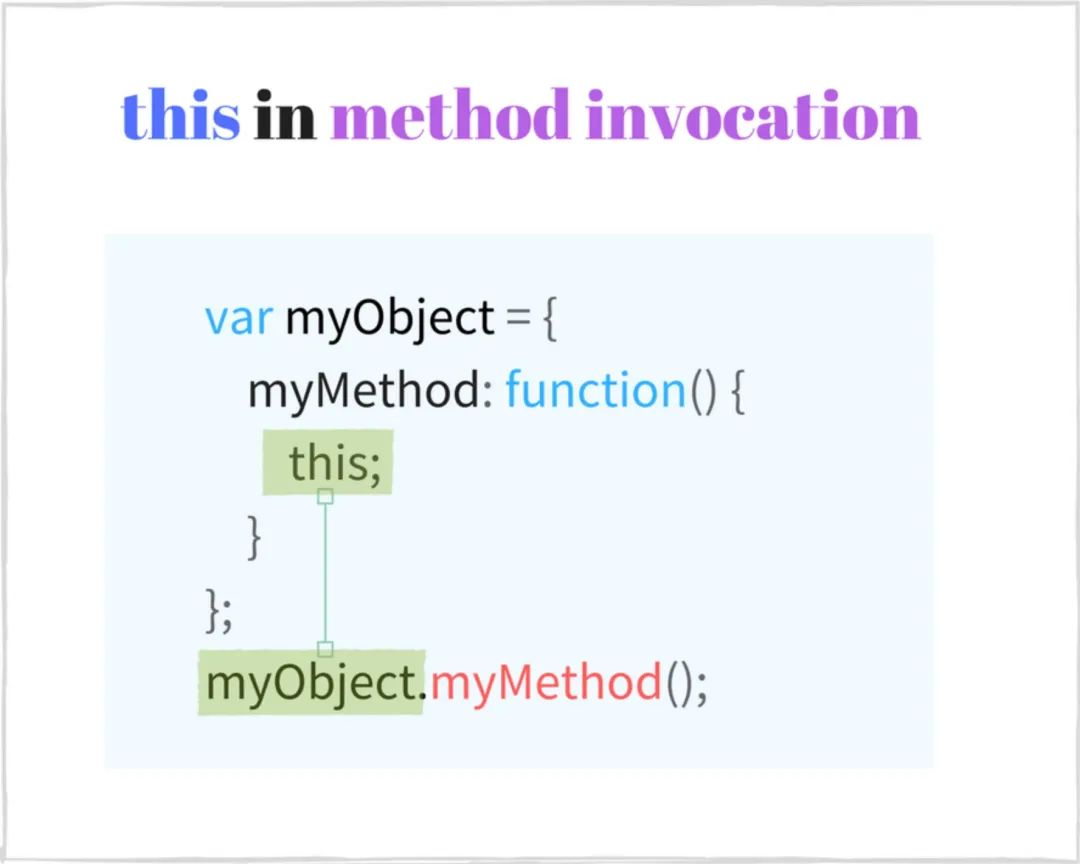
我们来看一个增加数字的例子。
const calc = {
num: 0,
increment() {
console.log(this === calc); // => true
this.num += 1;
return this.num;
}
};
// method invocation. this is calc
calc.increment(); // => 1
calc.increment(); // => 2通过方法调用的方式 calc.increment(),使得 increment 内部的 this 指向了 cals 对象,因此 this.num 会成功增加 num 属性的值。
让我们再看一个例子。对象通过原型继承一个方法,当方法通过属性访问器调用的时候,所继承的这个方法中的 this 也是指向对象本身:
const myDog = Object.create({
sayName() {
console.log(this === myDog); // => true
return this.name;
}
});
myDog.name = 'Milo';
// method invocation. this is myDog
myDog.sayName(); // => 'Milo'上边代码中,Object.create() 返回一个新对象 myDog,并且将它的原型对象指向第一个参数。myDog 对象会继承 SayName 方法。
在 ECMAScript 2015 中的 class 关键词里,方法调用中的上下文,也就是 this 同样指向它本身。
class Planet {
constructor(name) {
this.name = name;
}
getName() {
console.log(this === earth); // => true
return this.name;
}
}
const earth = new Planet('Earth');
// method invocation. the context is earth
earth.getName(); // => 'Earth'2.2 陷阱:将对象中的方法抽离
⚠️ 我们可以将对象中的方法提取出来做为一个独立的变量 const alone = myObj.myMethod。当调用函数的时候 alone(),由于它是从原来对象拆出来的,所以可能会认为函数中的 this 会指向 myObject。
然而,如果一个方法没有经过对象的属性访问器调用,那它就属于第一节介绍的「函数直接调用」类型,这里的 this 会指向全局对象 window 或者严格模式下的 undefined。
我们可以通过 bind 方法来修正这种情况,const alone = myObj.myMethod.bind(myObj)。
再看一个例子,我们通过构造函数 Pet 得到一个实例化对象 myCat。然后通过 setTimeout() 在一秒后打印对象内部的信息。
function Pet(type, legs) {
this.type = type;
this.legs = legs;
this.logInfo = function() {
console.log(this === myCat); // => false
console.log(`The ${this.type} has ${this.legs} legs`);
}
}
const myCat = new Pet('Cat', 4);
// logs "The undefined has undefined legs"
// or throws a TypeError in strict mode
setTimeout(myCat.logInfo, 1000);⚠️ 你也许会认为 setTimeout(myCat.logInfo, 1000) 将会调用 myCat.logInfo(),然后打印 myCat 的 type 和 legs。
但事与愿违,方法是从对象中抽离然后做为了一个参数,setTimout(myCat.logInfo) 等价于下边的代码。
setTimeout(myCat.logInfo);
// is equivalent to:
const extractedLogInfo = myCat.logInfo;
setTimeout(extractedLogInfo);当调用提取的 logInfo 的时候其实属于「函数直接调用」类型,所以 this 会指向全局对象 window 或者严格模式下的undefined ,而不会是 myCat 对象。因此 logInfo 函数并不能正确的打印相关的信息。
同样的,这种情况下我们可以使用 bind 来修复。
function Pet(type, legs) {
this.type = type;
this.legs = legs;
this.logInfo = function() {
console.log(this === myCat); // => true
console.log(`The ${this.type} has ${this.legs} legs`);
};
}
const myCat = new Pet('Cat', 4);
// Create a bound function
const boundLogInfo = myCat.logInfo.bind(myCat);
// logs "The Cat has 4 legs"
setTimeout(boundLogInfo, 1000);myCat.logInfo.bind(myCat) 会返回一个新的函数,会像 logInfo 那样执行,同时 this 会指向 myCat,即使我们是通过 「函数直接调用」。
当然,我们也可以使用箭头函数。
function Pet(type, legs) {
this.type = type;
this.legs = legs;
this.logInfo = () => {
console.log(this === myCat); // => true
console.log(`The ${this.type} has ${this.legs} legs`);
};
}
const myCat = new Pet('Cat', 4);
// logs "The Cat has 4 legs"
setTimeout(myCat.logInfo, 1000);如果你使用了 class,为了防止上边的问题,我们可以将箭头函数做为一个类属性。
class Pet {
constructor(type, legs) {
this.type = type;
this.legs = legs;
}
logInfo = () => {
console.log(this === myCat); // => true
console.log(`The ${this.type} has ${this.legs} legs`);
}
}
const myCat = new Pet('Cat', 4);
// logs "The Cat has 4 legs"
setTimeout(myCat.logInfo, 1000);3 . 构造函数调用
定义:以 new 关键词开头,接着是一个可以解析成函数对象的表达式,紧跟着左括号,然后是逗号分割的参数,最后是右括号。例如 new Pet('cat', 4)、 new RegExp('\\d')。
让我们定义 Country 函数,然后通过构造函数的方式调用:
function Country(name, traveled) {
this.name = name ? name : 'United Kingdom';
this.traveled = Boolean(traveled); // transform to a boolean
}
Country.prototype.travel = function() {
this.traveled = true;
};
// Constructor invocation
const france = new Country('France', false);
// Constructor invocation
const unitedKingdom = new Country;
france.travel(); // Travel to Francenew Country('France', false) 这种调用方式会创建一个新对象,它的 name 属性是 France。
如果构造函数不需要传递参数,我们可以省略到它的括号,new Country。
从 ECMAScript 2015 开始,Js 允许我们通过 class 关键词来定义构造函数。
class City {
constructor(name, traveled) {
this.name = name;
this.traveled = false;
}
travel() {
this.traveled = true;
}
}
// Constructor invocation
const paris = new City('Paris', false);
paris.travel();new City('Paris') 就是「构造函数调用」类型。创建的对象通过类中一个特殊的方法 constructor 来初始化,其中 this 就指向当前创建的新对象。
如果属性访问器 myObject.myFunction 通过 new 调用,那么这种就属于「构造函数调用」,而不再是「方法调用」。
举个例子,new myObject.myFunction():相当于先通过属性访问器抽离函数 extractedFunction = myObject.myFunction,然后通过构造函数的方法创建一个新对象 new extractedFunction()。
3.1 构造函数调用中的 this 指向
this 指向通过构造函数创建的新对象
构造函数的上下文是新创建的对象。构造函数通过传来的参数进行初始化对象,设置初始值、绑定事件监听函数等等。
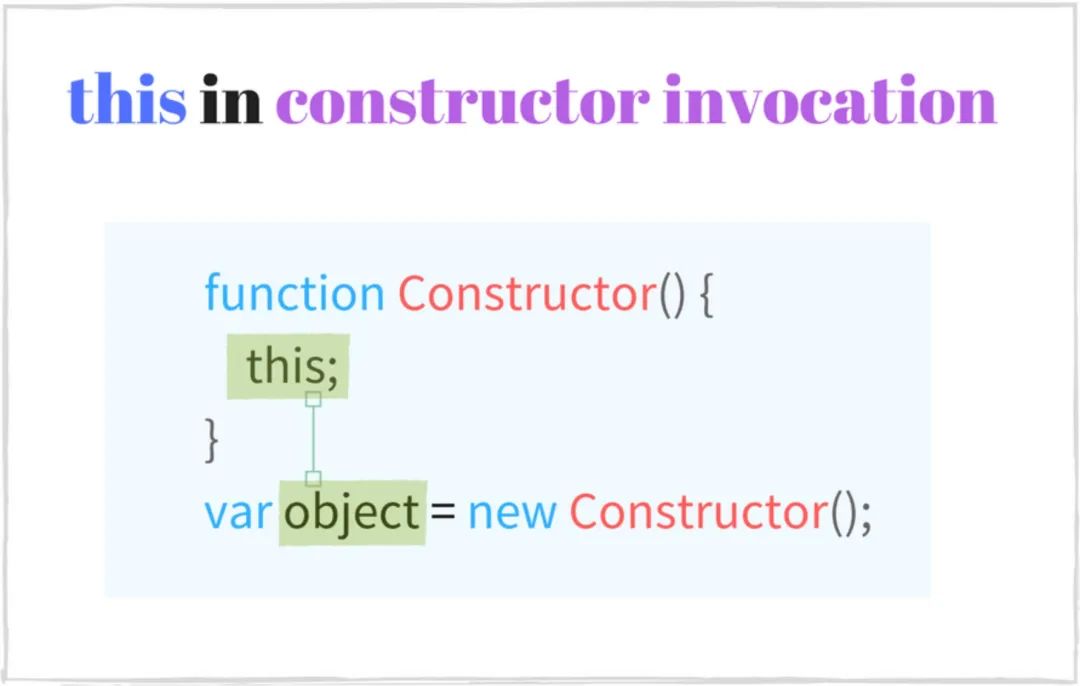
看一下下边的例子:
function Foo () {
// this is fooInstance
this.property = 'Default Value';
}
// Constructor invocation
const fooInstance = new Foo();
fooInstance.property; // => 'Default Value'new Foo() 通过构造函数的方式调用,其中的 this 就指向当前的对象 fooInstance,this.property 被初始化了一个值。
同样的情况在 class 中也是一样的,只不过初始化发生在 constructor 中。
class Bar {
constructor() {
// this is barInstance
this.property = 'Default Value';
}
}
// Constructor invocation
const barInstance = new Bar();
barInstance.property; // => 'Default Value'3.2 陷阱:忘记使用 new
有些 JavaScript 的函数除了可以通过构造函数创建对象,也可以通过函数直接调用的方式,比如 RegExp。
const reg1 = new RegExp('\\w+');
const reg2 = RegExp('\\w+');
reg1 instanceof RegExp; // => true
reg2 instanceof RegExp; // => true
reg1.source === reg2.source; // => true执行 new RegExp('\\w+') 和 RegExp('\\w+') ,Js 创建了等价的正则表达式对象。
⚠️ 通过函数直接调用的方式去创建对象可能会有潜在风险,因为如果不使用 new 关键词 一些构造函数可能会忽略掉属性的初始化。
看一下下边的例子:
function Vehicle(type, wheelsCount) {
this.type = type;
this.wheelsCount = wheelsCount;
return this;
}
// Function invocation
const car = Vehicle('Car', 4);
car.type; // => 'Car'
car.wheelsCount // => 4
car === window // => trueVehicle 在上下文对象中会初始化 type 和 wheelsCount 属性。当执行 Vehicle('Car', 4) 的时候将 car 对象返回,拥有正确的属性 car.type 和 car.wheelCount 。
上边看起来就是按照我们需要的样子进行的初始化,打印出来的值也都是正确的。
然而,Vehicle('Car', 4) 属于「函数直接调用类型」,因此它的 this 指向 window。所以,上边返回的 car 其实是 window 对象,将 type 和 wheelCount 属性都挂在了 window 上。
为了确保在使用构造函数的时候加上了 new 关键词,我们可以做一些改进:
function Vehicle(type, wheelsCount) {
if (!(this instanceof Vehicle)) {
throw Error('Error: Incorrect invocation');
}
this.type = type;
this.wheelsCount = wheelsCount;
return this;
}
// Constructor invocation
const car = new Vehicle('Car', 4);
car.type // => 'Car'
car.wheelsCount // => 4
car instanceof Vehicle // => true
// Function invocation. Throws an error.
const brokenCar = Vehicle('Broken Car', 3);通过判断 this instanceof Vehicle ,我们就可以保证当前的执行上下文环境是当前创建的新对象,保证 this 指向正确。
4 . 间接调用
this指向.call()或者.apply()所传的第一个参数
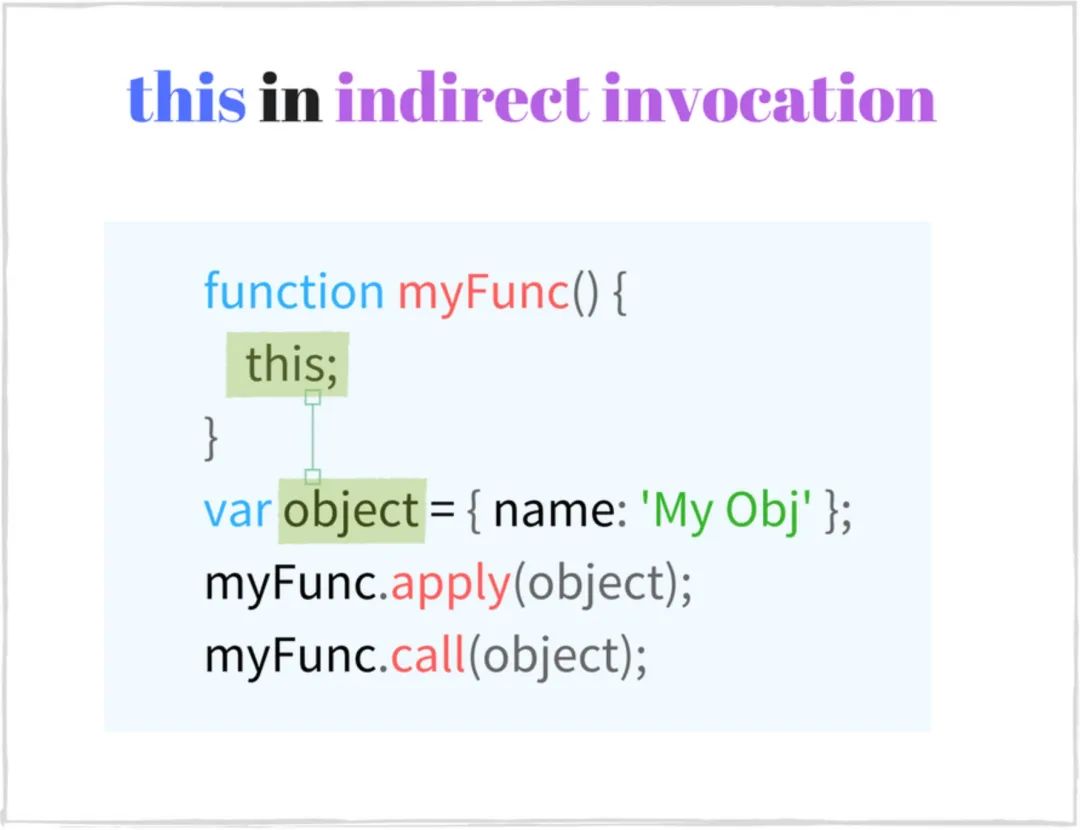
下边看一个例子:
const rabbit = { name: 'White Rabbit' };
function concatName(string) {
console.log(this === rabbit); // => true
return string + this.name;
}
// Indirect invocations
concatName.call(rabbit, 'Hello '); // => 'Hello White Rabbit'
concatName.apply(rabbit, ['Bye ']); // => 'Bye White Rabbit'间接调用方式对于修正函数的上下文执行环境很有用,例如上边我们介绍过的很多例子,当通过「函数直接调用」方式时,this 会指向 window 或者严格模式下的 undefined。此时我们就可以通过 .call() 或者 .apply() 将 this 指向我们需要的对象。
另一个经典的例子就是 ES5 中调用父类的构造函数。
function Runner(name) {
console.log(this instanceof Rabbit); // => true
this.name = name;
}
function Rabbit(name, countLegs) {
console.log(this instanceof Rabbit); // => true
// Indirect invocation. Call parent constructor.
Runner.call(this, name);
this.countLegs = countLegs;
}
const myRabbit = new Rabbit('White Rabbit', 4);
myRabbit; // { name: 'White Rabbit', countLegs: 4 }在 Rabbit 中调用 Runner.call(this, name) 使得在父函数中的 this 是当前子类相应的对象。
5 . 绑定函数
定义:执行上下文或者参数被绑定了具体值的函数。可以通过 .bind() 进行创建。原始函数和新的函数共享了相同的代码和作用域,但是执行的时候拥有不同的执行上下文和参数。
myFunc.bind(thisArg[, arg1, arg2, ...) 的第一个参数 thisArg 作为执行上下文,后边的 arg1, arg2, ... 是要预置的参数值。
看一下下边的例子:
function multiply(number) {
'use strict';
return this * number;
}
// create a bound function with context
const double = multiply.bind(2);
// invoke the bound function
double(3); // => 6
double(10); // => 20multiply.bind(2) 返回了一个新函数 double,相当于 2.multiply。
.bind() 和 .apply() 和 .call() 最大的不同就是,.bind() 是返回一个拥有预设的 this 和参数的新函数,后边还需要被调用才会执行。而 .apply() 和 .call() 是调用的时候就执行了。
5.1 绑定函数中的 this 指向
当执行一个绑定函数的时候,
this指向创建绑定函数myFunc.bind(thisArg)时候传的第一个参数。
.bind() 函数的作用就是创建一个新的函数,我们需要将要绑定的上下文环境作为第一个参数传给它。
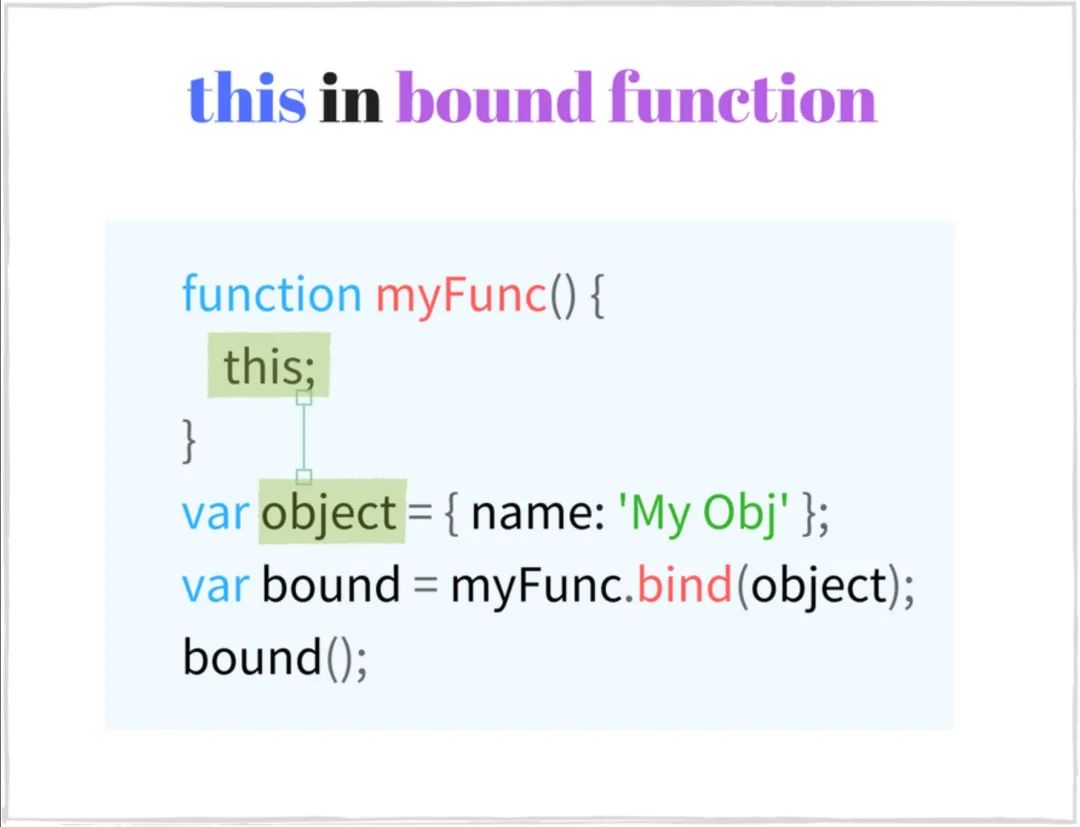
让我们看一下例子。
const numbers = {
array: [3, 5, 10],
getNumbers() {
return this.array;
}
};
// Create a bound function
const boundGetNumbers = numbers.getNumbers.bind(numbers);
boundGetNumbers(); // => [3, 5, 10]
// Extract method from object
const simpleGetNumbers = numbers.getNumbers;
simpleGetNumbers(); // => undefined or throws an error in strict mode通过 bind 绑定后返回的 boundGetNumbers 函数中 this 指向了传入的 numbers,因此当执行的时候返回的是传入的数组。
如果是简单的将 numbers.getNumbers 抽离出来作为一个新函数 simpleGetNumbers ,此时属于「函数直接调用类型」,因此 this 指向 window ,执行的时候就不是我们所期待的了。
5.2 牢固的上下文绑定
.bind() 会创造一个永久的上下文绑定,其中的 this 指向不会再发生改变。我们无法再通过 .call()、.apply() 或者 .bind() 来改变 this 指向。
唯一能够改变的方式就是通过构造函数调用,但平常开发中不建议采用这种调用方式。
function getThis() {
'use strict';
return this;
}
const one = getThis.bind(1);
one(); // => 1
one.call(2); // => 1
one.apply(2); // => 1
one.bind(2)(); // => 1
new one(); // => Object可以看一下上边的结果,只有 new one() 中的 this 指向来一个新对象,而其他方式中的 this 都是最初绑定的 1。
6 箭头函数
定义:箭头函数是定义函数的一种简写形式,并且它绑定的上下文是词法作用域确定的(简单理解就是 this 指向它定义位置的上下文)。
const hello = (name) => {
return 'Hello ' + name;
};
hello('World'); // => 'Hello World'
// Keep only even numbers
[1, 2, 5, 6].filter(item => item % 2 === 0); // => [2, 6]6.1 箭头函数中的 this
this指向定义箭头函数位置的上下文。
箭头函数不会创建自己的执行上下文,而是将 this 指向外部函数已经创建的执行上下文。
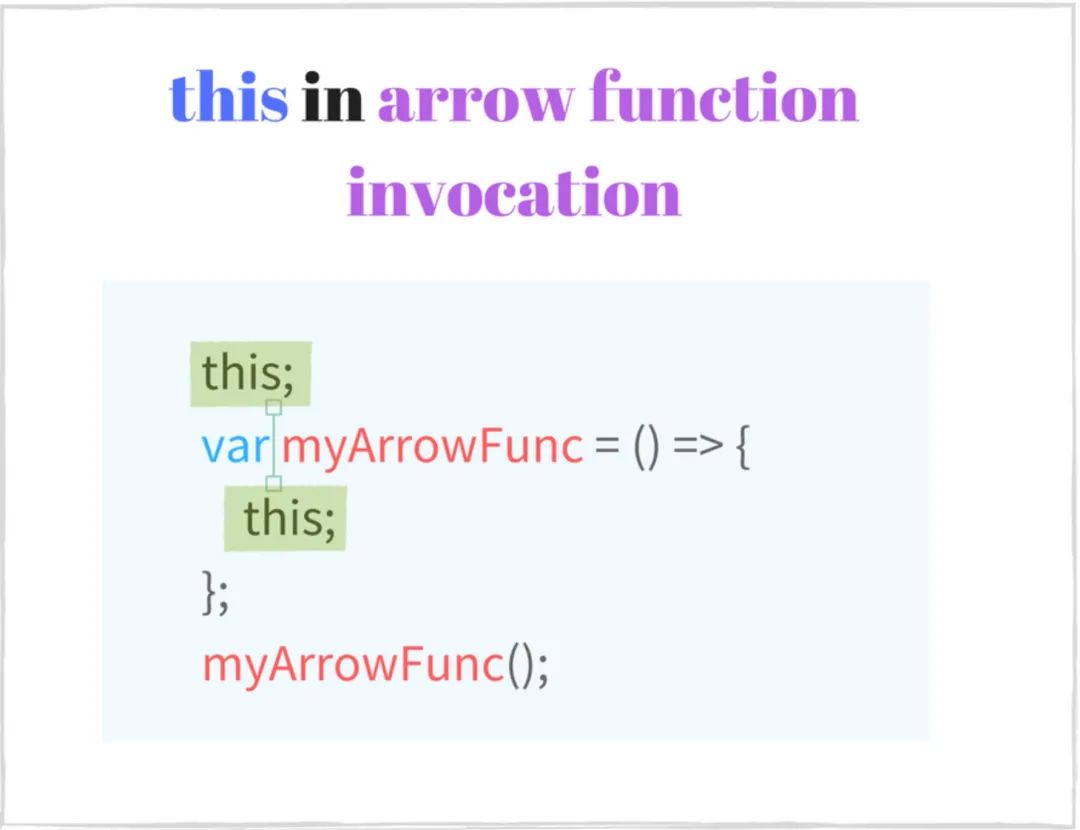
看一下例子:
class Point {
constructor(x, y) {
this.x = x;
this.y = y;
}
log() {
console.log(this === myPoint); // => true
setTimeout(() => {
console.log(this === myPoint); // => true
console.log(this.x + ':' + this.y); // => '95:165'
}, 1000);
}
}
const myPoint = new Point(95, 165);
myPoint.log();setTimeout() 调用箭头函数的时候,它的 this 会指向外部的执行上下文,也就是 myPoint。
如果箭头函数是定义在顶级作用域内(也就是函数外),this 将指向浏览器的全局对象 window,严格模式下也是一样的。
const getContext = () => {
console.log(this === window); // => true
return this;
};
console.log(getContext() === window); // => true箭头函数和 bind 函数一样,一旦确定了 this 指向就无法再改变了。
const numbers = [1, 2];
(function() {
const get = () => {
console.log(this === numbers); // => true
return this;
};
console.log(this === numbers); // => true
get(); // => [1, 2]
// Try to change arrow function context manually
get.call([0]); // => [1, 2]
get.apply([0]); // => [1, 2]
get.bind([0])(); // => [1, 2]
}).call(numbers);不论我们如何调用箭头函数,最终输出的依旧是最开始的绑定的 [1, 2]。
那构造函数可以改变 this 指向吗?不会的,调用箭头函数作为构造函数会抛出错误,TypeError: get is not a constructor。
6.2 陷阱:用箭头函数作为一个对象方法
⚠️ 既然箭头函数这么简洁方便,你可能想将对象的一个方法来用箭头函数声明,(param) => {...} 来代替 function(param) {..}。
看一下下边的例子:
function Period (hours, minutes) {
this.hours = hours;
this.minutes = minutes;
}
Period.prototype.format = () => {
console.log(this === window); // => true
return this.hours + ' hours and ' + this.minutes + ' minutes';
};
const walkPeriod = new Period(2, 30);
walkPeriod.format(); // => 'undefined hours and undefined minutes'因为 format 是一个箭头函数,所以它的 this 指向它定义地方的执行上下文,也就是这里的 window。
即使 format 是通过「方法调用」的形式 walkPeriod.format(),函数中的 this 依旧是指向最初定义时候的 window ,而不会改变成当前对象。
因此我们需要用 function 来定义函数。
function Period (hours, minutes) {
this.hours = hours;
this.minutes = minutes;
}
Period.prototype.format = function() {
console.log(this === walkPeriod); // => true
return this.hours + ' hours and ' + this.minutes + ' minutes';
};
const walkPeriod = new Period(2, 30);
walkPeriod.format(); // => '2 hours and 30 minutes'walkPeriod.format() 属于第 2 节介绍「方法调用」类型,所以 this 会指向调用它的对象 walkPeriod,最终也会打印正确的结果。
总结
通过上边的分析,我们发现影响 this 指向的其实是函数的调用类型,因此从现在起不要再问自己:
这个
this是怎么得到的?
而是问自己:
这个函数是属于哪种调用类型?
「函数直接调用」?「方法调用」?「构造函数调用」?「间接调用」?
如果是绑定函数就问自己:
这个函数
bind的时候传的什么参数?
如果是箭头函数就问自己:
箭头函数是在哪里定义的,它外部的执行上下文是什么?
通过上边的思路,可以使你不再对 this 感到头疼!